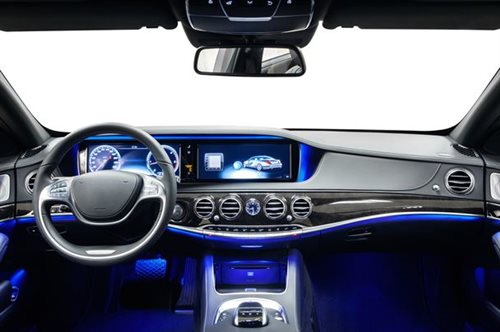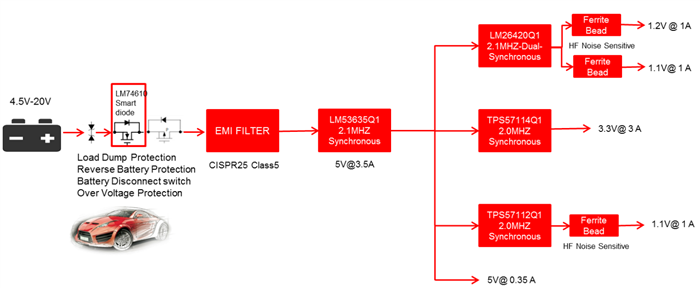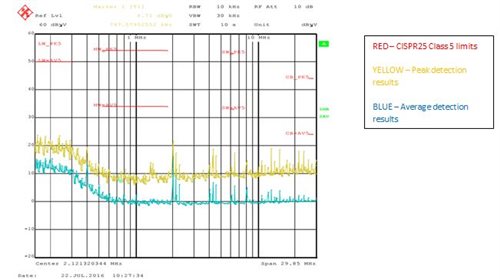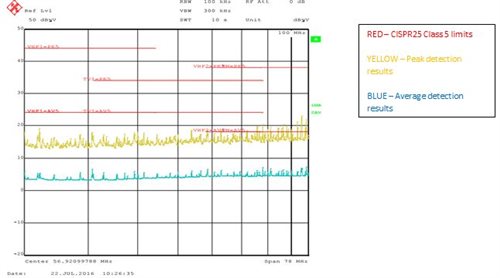SSZTA77 may 2017 LM26420-Q1 , LM53635-Q1 , LM74610-Q1

In a world of always-on experiences, drivers and passengers are looking to access real-time information about traffic conditions and potential hazards via traditional radio or human machine interface (HMI) systems. At the same time, drivers and passengers want to use connected devices like GPSs, smartphones and tablets without interference. Thus, it is important that these devices are not affected by electromagnetic interference (EMI), which occurs when placing a large amount of electrical and electronic systems in a confined space.
EMI compliance is an important topic for many major automotive manufacturers trying to build the newest systems for cars. Requirements are stringent and manufacturers must comply with standards like CISPR 25 Class 5 and in many cases if the standard is not met, then the system cannot be sold.
The level of EMI measurement in a system is subject to an engineer’s attention mostly in the later stages of design and validation. In many cases, the engineer discovers EMI problems when the board is assembled, after all components are chosen and validated separately. At this point it is very difficult to identify the exact source of EMI since the number of switching regulators has grown exponentially in today’s advanced automotive systems. For this reason, EMI test results utilizing a reference design board is useful for the engineer to get firsthand knowledge how the different parts work with each other once assembled together on the PCB board.
To guard against EMI problems later in the design of an automotive infotainment system for example, TI has developed the 17W System-Level Power Reference Design for Automotive Infotainment Processor Power. This off-battery system is optimized to withstand Comité International Spécial des Perturbations Radioélectriques (CISPR) 25 Class 5 EMI limits for powering automotive processors used in infotainment and cluster systems. The typical power architecture for an automotive infotainment processor is shown in Figure 1.
There are four major blocks in the reference design:
- The LM74610-Q1 smart diode has built in, front-end protection to withstand positive and negative pulses (International Organization for Standardization [ISO] 7630), reverse battery protection, a battery disconnect switch and overvoltage protection (OVP).
- A common-mode and differential filter suppresses conducted EMI.
- The LM53635-Q1 2.1MHz, fully synchronous, 3.5A DC/DC converter converts the battery voltage to a 5V rail. This device is available in an automotive-qualified flip-chip on-lead (FCOL) package with wettable flanks to minimize switch-node ringing. This DC/DC converter has low EMI characteristics using a spread-spectrum option.
- Downstream point-of-load (POL) buck converters, such as TI’s TPS57112-Q1, TPS57114-Q1 and LM26420-Q1, provide low input voltage rails for processing power. Ferrite beads are used to remove high frequency noise on downstream power rails.
 Figure 1 Typical Power Architecture for
an Automotive Infotainment Processor
Figure 1 Typical Power Architecture for
an Automotive Infotainment ProcessorThe reference design has been tested and successfully passed CISPR 25 Class 5 conducted EMI limits.
Figure 2 shows test results for up to 30MHz of conducted emissions – peak and average detection – using all of the DC/DC switching regulators with a full load.
 Figure 2 Conducted EMI Results with
Frequency Range below 30MHz
Figure 2 Conducted EMI Results with
Frequency Range below 30MHzFigure 3 shows the test results for 30MHz to 108MHz of conducted emissions with the same conditions.
 Figure 3 Conducted EMI Results with
Frequency Range between 30MHz and 108MHz
Figure 3 Conducted EMI Results with
Frequency Range between 30MHz and 108MHzA reference design is a useful tool for an engineer to review EMI results and identify possible interference problems early in the design cycle. Measuring conducted EMI on a reference design board can help to identify noise trends and early compliance issues that might not appear until the final product design. Download the 17W System-Level Power Reference Design for Automotive Infotainment Processor Power reference design or get more information on TI’s power products for automotive applications.